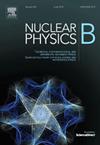Non-commutative gravastar configuration in f(R,Lm,T) gravity
IF 2.8
3区 物理与天体物理
Q2 PHYSICS, PARTICLES & FIELDS
引用次数: 0
Abstract
This study explores the possibility of gravastar solutions in the context of gravity, a variation that incorporates the Ricci scalar R, trace of the energy-momentum tensor T and the matter Lagrangian with particular coupling strengths α and β. Also, we explore the interior of a gravastar within a framework motivated by non-commutative geometry, providing a physical justification for this choice. The thin shell is modeled as stiff matter, and two distinct exterior space-times, namely Reissner-Nordstrom and Bardeen metrics, are employed to construct the gravastar model. We examine the physical characteristics of these models, including proper length, entropy, energy, and the equation of state. We analyze the thin shell's effective pressure, energy density, and potential by utilizing the Israel junction conditions. Additionally, we discuss the stability of the thin shell and investigate the deflection angle it causes, which could be probed with future radio telescopes such as the Event Horizon Telescope (EHT). Finally, the surface redshift of the gravastar is evaluated, highlighting its relevance for potential observational detection.
f(R,Lm,T)重力下的非交换重力星构型
本研究探讨了重力f(R,Lm,T)背景下gravastar解的可能性,重力f(R,Lm,T)是一种包含里奇标量R、能量动量张量T的迹线和具有特定耦合强度α和β的物质拉格朗日Lm的变化。此外,我们在非交换几何的框架中探索了gravastar的内部,为这种选择提供了物理上的理由。薄壳被建模为刚性物质,并使用两个不同的外部时空,即Reissner-Nordstrom和Bardeen度量来构建gravastar模型。我们研究了这些模型的物理特性,包括适当的长度、熵、能量和状态方程。我们利用以色列结条件分析了薄壳的有效压力、能量密度和势能。此外,我们还讨论了薄壳的稳定性,并研究了它引起的偏转角,这可以用未来的射电望远镜(如事件视界望远镜(EHT))来探测。最后,对重力星的表面红移进行了评估,强调了其与潜在观测探测的相关性。
本文章由计算机程序翻译,如有差异,请以英文原文为准。
求助全文
约1分钟内获得全文
求助全文
来源期刊

Nuclear Physics B
物理-物理:粒子与场物理
CiteScore
5.50
自引率
7.10%
发文量
302
审稿时长
1 months
期刊介绍:
Nuclear Physics B focuses on the domain of high energy physics, quantum field theory, statistical systems, and mathematical physics, and includes four main sections: high energy physics - phenomenology, high energy physics - theory, high energy physics - experiment, and quantum field theory, statistical systems, and mathematical physics. The emphasis is on original research papers (Frontiers Articles or Full Length Articles), but Review Articles are also welcome.
 求助内容:
求助内容: 应助结果提醒方式:
应助结果提醒方式:


